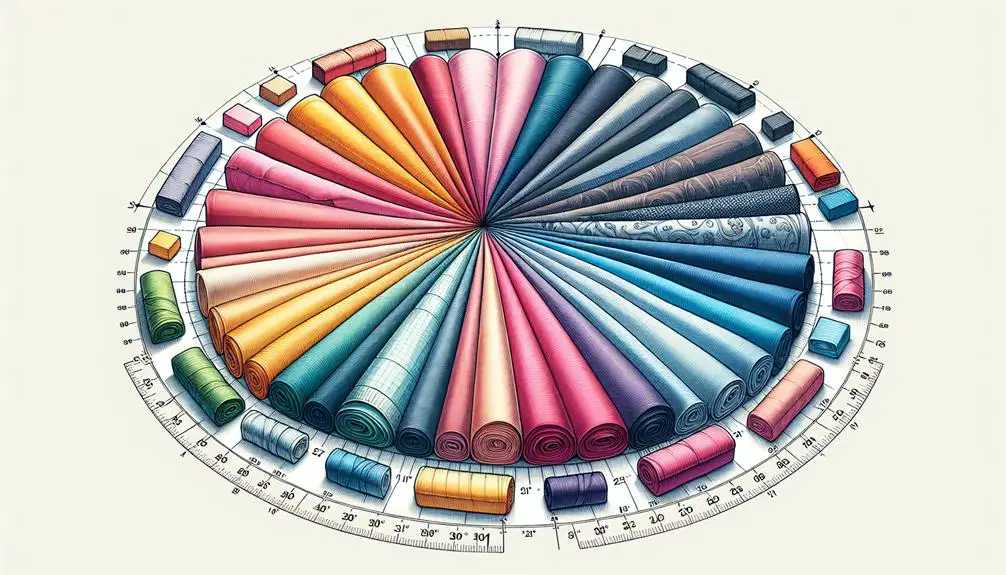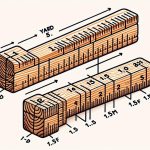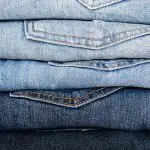Ever wondered how many fat quarters fit into a yard of fabric? Well, the answer might surprise you. Understanding this can open up a world of possibilities for your crafting projects.
Let's uncover the mystery behind fat quarters and their unique role in the world of sewing and quilting. The magic lies in the versatility they offer, but there's more to explore beyond just the numbers.
Let's unravel the secrets of fat quarters and discover the endless creativity they can bring to your next creation.
Table of Contents
Key Takeaways
- One yard of fabric equals 4 fat quarters, each measuring approximately 18 x 22 inches.
- Fat quarters offer flexibility in cutting shapes and designs efficiently.
- Simplifies fabric calculations for quilting projects accurately.
- Ideal for mixing and matching patterns, providing ample fabric for creative endeavors.
Definition of Fat Quarter
A fat quarter is a fabric cut that provides more width and versatility for crafting projects like quilting and sewing. Unlike a regular quarter yard of fabric, which measures 9 x 44 inches, a fat quarter is a quarter of a yard of material that measures approximately 18 x 22 inches. This wider cut allows for more flexibility in cutting shapes and pieces for various projects. In quilting, fat quarters are especially popular because they can accommodate larger pieces and intricate designs more effectively than traditional quarter yard cuts.
When working on quilting projects that require different fabric designs or a wider surface area, fat quarters are a go-to choice. They're also handy for adding variety to fabric stashes, quilt blocks, and applique projects. Since four fat quarters make up a yard of fabric, they're commonly used in quilting and sewing to mix and match patterns and colors seamlessly. Their versatility and practicality make fat quarters a staple in any crafter's toolkit.
Understanding Fat Quarter Measurements
So, let's talk about the key points when it comes to understanding fat quarter measurements.
The size of a fat quarter, the conversion from a yard to fat quarters, and the best ways to cut fat quarters for your projects are all essential aspects to grasp.
Knowing these details will help you make the most of your fabric and create beautiful quilting pieces efficiently.
Fat Quarter Size
Exploring the dimensions of a fat quarter reveals its practicality and versatility in crafting projects. A standard fat quarter size measures 18 x 22 inches, making it a convenient option for various sewing endeavors. This size provides ample fabric to work with, allowing for intricate designs and patterns.
When compared to other fabric cuts, fat quarters offer a balanced mix of width and length, ideal for quilting and patchwork. The dimensions of a fat quarter make it easy to handle and cut, simplifying the process of creating quilt blocks and other sewing projects.
Understanding the size of a fat quarter is key to maximizing its potential in crafting endeavors, enabling precise and efficient fabric usage.
Yard to Fat Quarter
After understanding the dimensions of a fat quarter, it's essential to grasp the concept of converting yards to fat quarters for efficient fabric planning and utilization. When converting yards to fat quarters, consider the following:
- 4 Fat Quarters in a Yard: Remember that 1 yard of fabric is equivalent to 4 fat quarters.
- Measurement Consideration: Each fat quarter measures approximately 18 x 22 inches, providing ample fabric for various projects.
- Versatile Cutting Options: Fat quarters offer flexibility in cutting shapes and designs due to their manageable size.
- Efficient Fabric Planning: Utilize fat quarters to introduce diversity and creativity into your quilting projects.
- Simplified Calculations: Knowing the conversion simplifies fabric calculations, ensuring accurate measurements for your quilting endeavors.
Cutting Fat Quarters
Understanding the measurements of fat quarters is crucial for efficiently utilizing fabric in quilting and sewing projects. When cutting fat quarters, you divide the fabric into four equal pieces, each measuring approximately 18 x 22 inches.
This cutting method provides versatility for various projects due to the wider width of fat quarters compared to regular quarters. To create these dimensions, you need to cut the fabric both widthwise and lengthwise. This process allows for easier handling of fabric pieces and better utilization of materials.
Fat quarters, with their adaptability and unique size, are commonly used in quilting to achieve intricate designs and patterns. Mastering the cutting of fat quarters is essential for optimizing fabric usage in creative endeavors.
Calculating Fat Quarters in a Yard
Calculating the number of fat quarters in a yard is simple: there are 4 fat quarters in a yard of fabric. When working on quilting projects, understanding fabric increments and utilizing fat quarters can be incredibly beneficial.
- A standard fat quarter measures approximately 18 x 22 inches.
- Fat quarters are commonly used in quilting projects for their versatility.
- Understanding fabric increments: 1 yard equals 36 inches, and quilting fabric is typically 44 inches wide.
- Fat quarters provide flexibility in fabric usage and design choices.
Converting Yardage to Fat Quarters
When converting yardage to fat quarters, it's important to consider the size of the fabric cuts needed. Understanding how many fat quarters make up a yard can help in planning projects effectively.
Let's break down the process of converting yardage to fat quarters for seamless fabric cutting.
Yardage to Fat Quarters
To convert yardage to fat quarters, simply divide the total yards of fabric by 1 to determine the corresponding number of fat quarters. When working on quilting projects, this conversion is crucial for accurate fabric planning. Here are some key points to consider:
- Remember, there are 4 fat quarters in a yard of fabric.
- A standard fat quarter typically measures 18 x 22 inches.
- Fat quarters are popular in quilting projects due to their versatility.
- Understanding fabric increments is essential; 1 yard equals 36 inches.
- Fat quarters offer flexibility in fabric usage and enable diverse design choices.
Calculating Fabric Cuts
Looking at a yard of fabric, you can easily envision how it neatly divides into four fat quarters, each measuring about 18 x 22 inches.
When it comes to calculating fabric cuts for your projects, understanding how to convert yardage to fat quarters is key. To convert yardage to fat quarters efficiently, simply divide the total yardage by 0.25 since each fat quarter represents 1/4 of a yard.
This knowledge of fabric increments simplifies the process and helps you plan your projects accurately. For quilting endeavors, knowing the relationship between fat quarters and yards is invaluable. By multiplying the number of fat quarters needed by 0.25, you can determine the corresponding yardage required for your fabric cuts.
Cutting Your Own Fat Quarters
For cutting your own fat quarters, begin by slicing a half-yard piece of fabric straight down the middle. This process allows you to create fat quarters tailored to your preferences, especially if you have specific fabric patterns in mind.
Here are some steps to guide you through cutting your own fat quarters:
- Open each half-yard piece and cut along the fold line to create four fat quarters.
- The resulting fat quarters will measure approximately 18 x 22 inches each.
- Accuracy in cutting along the fold line is crucial for consistent fat quarter sizes.
- Cutting your own fat quarters enables you to customize your projects and mix different patterns creatively.
- Take your time and ensure precise cutting to maximize the use of fabric and achieve the desired results with your fat quarters.
Maximizing Fat Quarter Usage
When it comes to maximizing fat quarter usage, one key strategy is to carefully plan your cuts to minimize fabric waste and create stunning projects. By understanding that there are 4 fat quarters in a yard of fabric, you can efficiently utilize these pieces to their full potential. Fat quarters, measuring 18 x 22 inches each, offer versatility in cutting and design options, allowing for diverse fabric selections in your projects. To aid in efficient planning, knowing how to convert fat quarters to yards is essential. Here's a table showcasing the comparison between fat quarters and yards:
| Measurement | Fat Quarters | Yards of Fabric |
|---|---|---|
| Length | 18 inches | 36 inches |
| Width | 22 inches | 44 inches |
| Total Area | 396 sq. inches | 1584 sq. inches |
Differences in Fat Quarter Sizes
Comparing fat quarters to quarter yards reveals distinct differences in size and versatility for various crafting projects. Fat quarters, typically 18 x 22 inches, provide ample space for creative cutting and design possibilities. On the other hand, quarter yards, measuring 9 x 44 inches, offer a longer but narrower piece of fabric more suitable for certain techniques like strip piecing or quilt bindings.
Here are some key differences between fat quarters and quarter yards:
- Fat quarters contain more width for varied cutting and design options.
- Quarter yards are ideal for strip piecing and cutting quilt bindings.
- Fat quarters enable more efficient cutting with less piecing required.
- Quarter yards offer a longer piece of fabric but with less width.
- Understanding these distinctions helps in selecting the most appropriate fabric cut for different projects.
Benefits of Using Fat Quarters
Using fat quarters enhances creativity and versatility in various crafting projects by providing a wide variety of fabric choices within a yard. Fat quarters are a cost-effective way to experiment with new fabrics and build a diverse collection for your projects. Here is a table highlighting the benefits of using fat quarters:
| Benefits of Using Fat Quarters |
|---|
| 1. Variety of Fabrics |
| 2. Cost-Effective |
| 3. Creative Cutting Options |
| 4. Ideal for Quilt Patterns |
| 5. Versatile in Crafting Projects |
Fat quarters offer a diverse selection of fabrics within a single yard, making them perfect for adding flair to quilt blocks, stash enhancement, and applique projects. Their larger surface area allows for more creative cutting possibilities compared to regular quarter yards, enabling you to explore different design options. Additionally, many quilt patterns are tailored for fat quarters due to their versatility in cutting, making them a popular choice among crafters looking to add depth and variety to their work.
Exploring Other Pre-Cut Fabric Sizes
Discover the world of pre-cut fabric sizes beyond fat quarters with charm packs, jelly rolls, and layer cakes, offering convenience and variety for your quilting and sewing projects.
Charm packs are bundles of 5-inch squares, providing a diverse selection of coordinated fabrics perfect for small projects or adding variety to larger ones.
Jelly rolls, consisting of 2.5-inch strips, offer a quick way to access a range of fabrics without the need for cutting, making them ideal for strip quilts or projects requiring long strips of fabric.
Layer cakes, with 10-inch squares, are versatile for creating larger blocks or intricate designs, showcasing a variety of prints and colors.
Each pre-cut fabric size serves a specific purpose in quilting, streamlining the fabric selection process and enabling efficient coordination of colors and patterns.
Explore these pre-cut options to enhance your quilting experience with ease and creativity.
Frequently Asked Questions
How Many Fat Quarters Can You Get From a Yard?
I can create a colorful quilt with four fat quarters from a yard of fabric. Each fat quarter is a small piece of a bigger picture, offering versatility and creativity in crafting projects.
Is a Fat Quarter the Same as a 1 4 Yard?
A fat quarter is not the same as a 1/4 yard of fabric. While a fat quarter measures 18 x 22 inches, a 1/4 yard is 9 x 44 inches. Understanding this difference is crucial for accurate fabric measurements in quilting.
How Do You Convert Fat Quarters to Yardage?
Converting fat quarters to yardage is simple! Multiply the number of fat quarters by 0.25. For instance, 4 fat quarters make a yard. It's a breeze with basic math skills, making fabric planning a cinch.
How Much Fabric Is 12 Fat Quarters?
When I think of how much fabric 12 fat quarters make, it's fascinating. The total area from these quilting gems equals 54 square feet. The versatility they offer in creating and crafting is simply amazing!
- Tetron Fabric for Marine Applications: Durability and Use Cases - June 18, 2025
- Tetron Fabric for Outdoor Furniture: Weather Resistance and Care - June 18, 2025
- Tetron Fabric for Wall Coverings: Style and Application Tips - June 18, 2025







